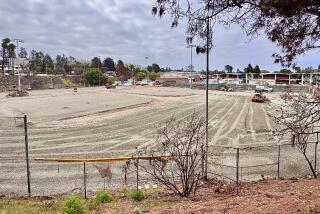Wait Over at Kennedy High
- Share via
GRANADA HILLS — Jennifer Walsh, a senior at John F. Kennedy High, was certain she’d graduate before the school finished rebuilding from the 1994 Northridge earthquake.
And who can blame her? It’s been a slow process that has dragged out nearly five years and forced students to attend classes in bungalows scattered over the school’s two parking lots.
“I thought for sure I’d be long gone before the construction was done,” Jennifer said.
But this week, Kennedy celebrated the completion of two buildings that replace a three-story structure destroyed in the Jan. 17, 1994, temblor that housed administration offices and 20 classrooms.
Principal Warren Mason said students and administrators are expected to move into the new buildings by Dec. 5.
“It’s about time!” said 17-year-old senior Alexandra Gonzalez. “I can’t believe it’s finally done.”
Although Kennedy was among the hardest hit campuses in the Los Angeles Unified School District, money to rebuild was unavailable until almost three years after the jolt, because the federal agency providing funding was inundated with claims, school officials said.
The project, funded by the Federal Emergency Management Agency, cost $7 million and took about 18 months to complete.
Two separate buildings were created, because a poll among teachers revealed most didn’t want another three-story structure like the old one.
The new main building, which has two levels, will house the administration and health offices, as well as 17 classrooms, a computer lab and a parents’ center.
Adjacent to it is a single-story structure with six classrooms and two department offices.
Several students and administrators were happy to see state-of-the-art conditions.
“There’s a 100% difference from the old rooms,” Mason said. “These are technological buildings with every modern thing that can be in a school in 1998.”
Each classroom has cable TV hookups and five computer outlets, and all are equipped with sophisticated alarm systems and skylights. Sometime in December, the computer network system will be connected.
“It looks more like a college now,” said senior Cheria Avarca, 17. “It’s very high-tech.”
And leaving the cramped bungalows set up in the school parking lot will be a relief, several students said.
“It was really a big pain in those bungalows, because it was all crowded,” said senior Evelio Franco, also 17. “Going back to a normal classroom is going to be great. I don’t know anybody who isn’t looking forward to it.”
About half of the bungalows are scheduled to be removed before the December holiday break, Mason said, and the rest will go during summer vacation.
“It’s going to be real nice to have parking spaces on campus,” Mason said. “We haven’t had that in a long time.”
And administrators said they appreciate having real offices. Since the earthquake, they’ve worked out of a building that was once a row of shop classes.
Mason shared a room with the faculty copy and fax machines, a refrigerator and a microwave oven.
“There were always lots of people coming in and out,” he said, laughing. “I certainly won’t miss that.”
More to Read
Sign up for Essential California
The most important California stories and recommendations in your inbox every morning.
You may occasionally receive promotional content from the Los Angeles Times.













